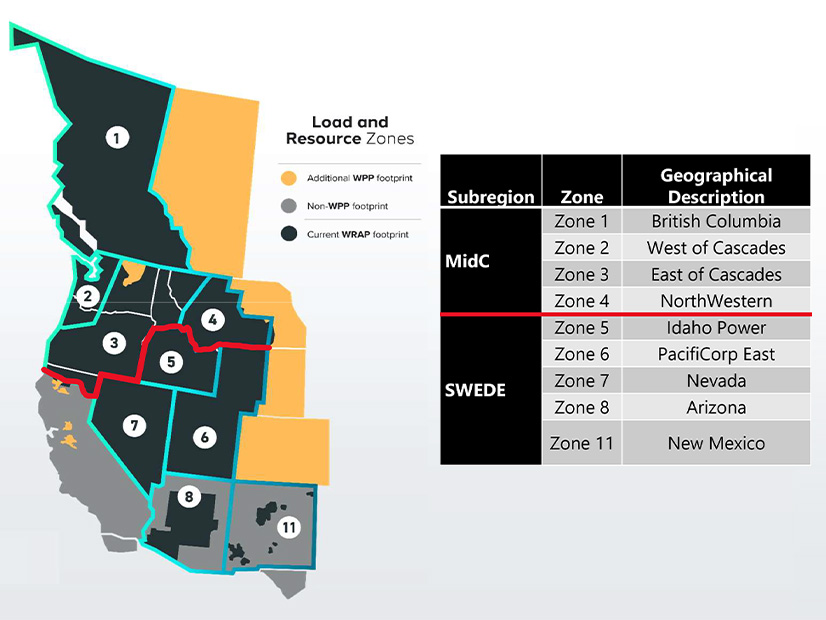Citing “significant new headwinds” to securing energy resources, participants in the Western Resource Adequacy Program (WRAP) are seeking to delay the program’s “binding” penalty phase by one year, to summer 2027.
Members of the voluntary program run by the Western Power Pool (WPP) face a May 31 deadline to commit to binding operations for summer 2026.
Once committed, participants will be at risk of incurring significant penalties for coming into a binding season with capacity deficiencies compared with their “forward showing” of promised resources for that season. The penalties are based on a formula set out in the WRAP tariff, which FERC approved in February 2023.
“Some WRAP participants have expressed concerns about their ability to meet WRAP forward-showing requirements in the next few years,” members of the WRAP’s Resource Adequacy Participants Committee (RAPC) said in an April 22 letter addressed to “Western Stakeholders.”
“They are understandably concerned, due to the reasons outlined [in the letter], about moving into binding operations given the potential magnitude of deficiency charges currently included in the tariff,” the RAPC wrote.
Those reasons include:
-
- “supply chain issues and other challenges” that “have slowed our ability to deliver and interconnect new resources”;
- regional peak load growing at a rate “faster than previously expected, driven primarily by electrification and data center expansion”; and
- “extreme weather events” that have “further challenged” the region’s assumptions about the volume of resources necessary to maintain reliability.
The RAPC wrote that the WRAP “remains a critical tool” for addressing those challenges, having “shown its value by helping quantify where we stand and where we need to go.”
“We plan to continue our best efforts to acquire and interconnect sufficient new resources to meet load growth as we strive to meet WRAP’s regional resource adequacy metrics,” it said. “We have been actively engaged in conversations with each other and Western Power Pool about when a critical mass of participants can enter binding operations of WRAP together.”
The WRAP tariff gives the WPP the flexibility to begin binding operations between 2025 and 2028. That means the RAPC’s request to shift the start date to 2027 is subject to stakeholder approval but would not require a tariff change.
“Once the revised transition plan is ready, we will submit the plan for consideration by stakeholders and the WRAP Board of Directors, following the WRAP governance process,” the RAPC wrote.
Seeking ‘Critical Mass’
In a statement responding to the RAPC letter, WPP CEO Sarah Edmonds said her organization has “worked closely” with WRAP members as they’ve considered their decision and will continue to work with them on a proposal for transitioning to binding operations.
“Our goal has always been to have a critical mass of participants in a binding program so that the West will be able to address urgent reliability needs,” Edmonds said. “That has not changed, though when and how we get there may look different than planned. Like the participants, our efforts will be focused on gaining commitment from a critical mass of participants for summer 2027.”
In a March 2023 briefing of the WECC Board of Directors, Edmonds said she hoped to see the WRAP become binding as soon as possible, but she acknowledged the binding phase still could be years away. (See WPP CEO Looks to ‘Earliest Possible’ Binding Season for WRAP.)
“To be candid, some load-serving entities are in better shape to go binding than others. Others need a little more time to adjust their procurement strategies and their positions relative to what they see coming at them,” she had said.
The WRAP participants’ move for a one-year delay indicates the RA situation in the West likely has deteriorated significantly since then.
“There is a legitimate question about whether the West will have adequate resources in the years to come. WRAP is the only regional program that specifically addresses that question,” Edmonds said in her April 22 statement.
She said WPP now will focus on how to “collect more and better data from participants” for use in “more transparent regional discussions about events where capacity is constrained as we work toward going binding.”
Role in Broader Markets
While the WPP developed the WRAP and oversees its governance, the program’s technical operations fall to SPP, whose Markets+ day-ahead offering is competing for Western participants with CAISO’s Extended Day-Ahead Market (EDAM).
Under the tariff SPP filed with FERC last month, Markets+ participants would be required to participate in the WRAP. That integration was cited by Bonneville Power Administration staff in their recommendation this month that the federal power marketing administration choose the SPP-run market over EDAM. (See BPA Staff Recommends Markets+ over EDAM.)
“WRAP has become the dominant resource adequacy program outside of California,” BPA staff said in their recommendation. “The EDAM proposal does not propose a uniform adequacy metric or require EDAM entities to participate in a resource adequacy program. Bonneville staff supports and prefers the clear and consistent requirement that all Markets+ [load-responsible entities] must participate in WRAP, which better supports regional reliability.”
The WPP has not weighed in on the competition between Markets+ and EDAM, instead emphasizing the need for the West to have a sound platform for reliability.
“We welcome the various markets in development or under discussion in the West, but their benefit comes with the efficient and economic dispatch of resources at times of need,” Edmonds said in her statement. “That only works if there are adequate planned resources available to dispatch.”


